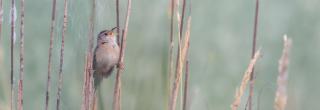| Scientific Name |
Cistothorus platensis |
| General Description |
Brown body, short, stiff tail, streaked back, and orange-buff rump. |
| Body length |
4.5 inches |
| Wing span |
5.5 inches |
| Weight |
0.32 ounces |
| Habitat/Nesting habitat |
Sedge wrens prefer tall, dense vegetation of grasses and sedges in wet meadows, CRP, DNC, hayfields, the edges of wetlands, and lightly grazed pasture. In wet years, use upland grasslands which may include big bluestem, Indiangrass, reed canary grass or switchgrass. May be less common during dry years but will use wet meadows during those times. Sedge wrens prefer large areas of contiguous grassland habitat and typically avoid cropland and woody cover. Nest located in dense growth of sedges or tall grasses and is a woven ball of fine grasses or sedges about 10-90 cm above the ground. |
| Breeding season |
Peak breeding season occurs from mid-June to early August. |
| Status in North Dakota |
Fairly common. Present in North Dakota from May to mid-October. |
| Food habits |
Primary food includes insects and spiders. |

